December 2020
If you are a basketball fan, avert your eyes. You may not be able to handle the truth.
An American ethno-centric view of history would claim basketball as a quintessential U.S. invention and research on the history of basketball offers a clear narrative about how this form of ball in hoop sport came to be. Here is the “standard” historic explanation of basketball….
“The only major sport strictly of U.S. origin, basketball was invented by James Naismith (1861–1939) on or about December 1, 1891, at the International YMCA Training School (now Springfield College) in Massachusetts, where Naismith was an instructor in physical education.
For that first game of basketball in 1891, Naismith used two half-bushel peach baskets as goals, which gave the sport its name. The students were enthusiastic. After much running and shooting, William R. Chase made a mid court shot ~ the only score in that historic contest. Word spread about the newly invented game, and numerous associations wrote Naismith for a copy of the rules, which were published in the January 15, 1892, issue of the Triangle, the YMCA Training School’s campus paper.”
And so the “legend” of basketball as a US invention began. But to each legend is usually a corresponding historical fact. Here therefore is a set of historical facts to consider:
A precursor to Basketball was widely played as a sport in the Mayan world. Centuries ago. Millenia ago. Some slight adjustments were made over time, but the ancient warriors of the Mayan world passed a ball amongst two competing teams’ members and sought to score points by throwing the ball through a hoop on opposites sides of the rectangular court.
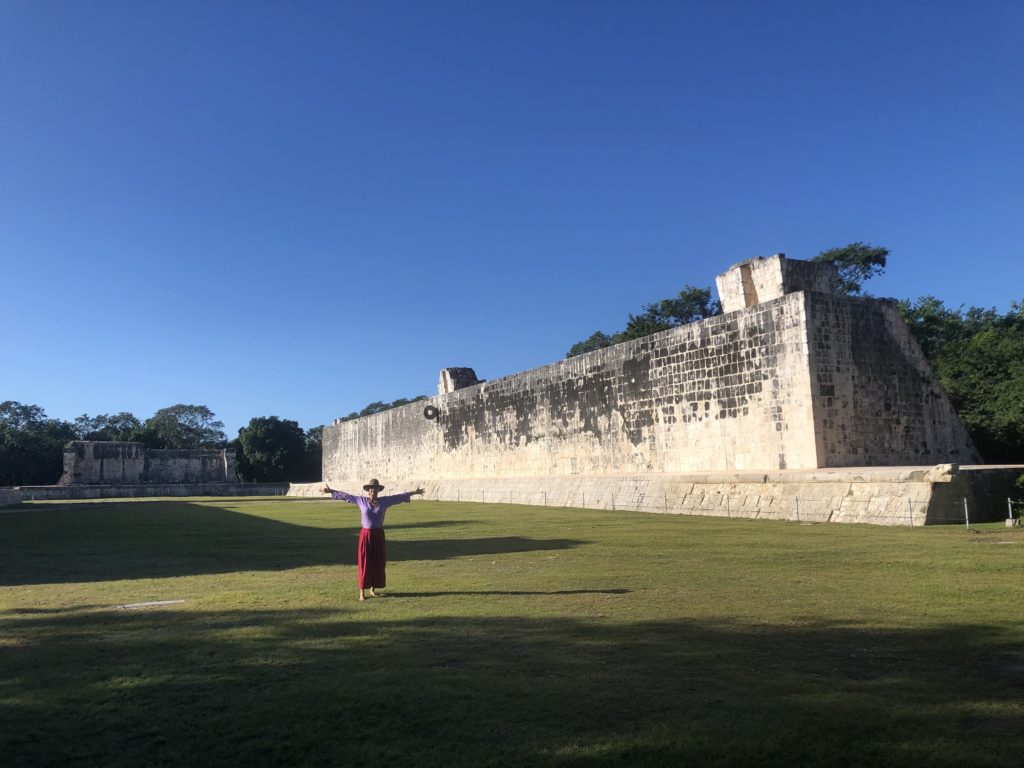
The wikipedia gurus tell us that “Maya Ballgame is a sporting event that was played throughout the Meso-American era by the Mayan civilization. One of the common links of the Mayan culture of Mexico, Guatemala, Honduras, and Belize is the game played with a rubber ball.”
The ball court itself was a focal point of Mayan cities and symbolized the city’s wealth and power.
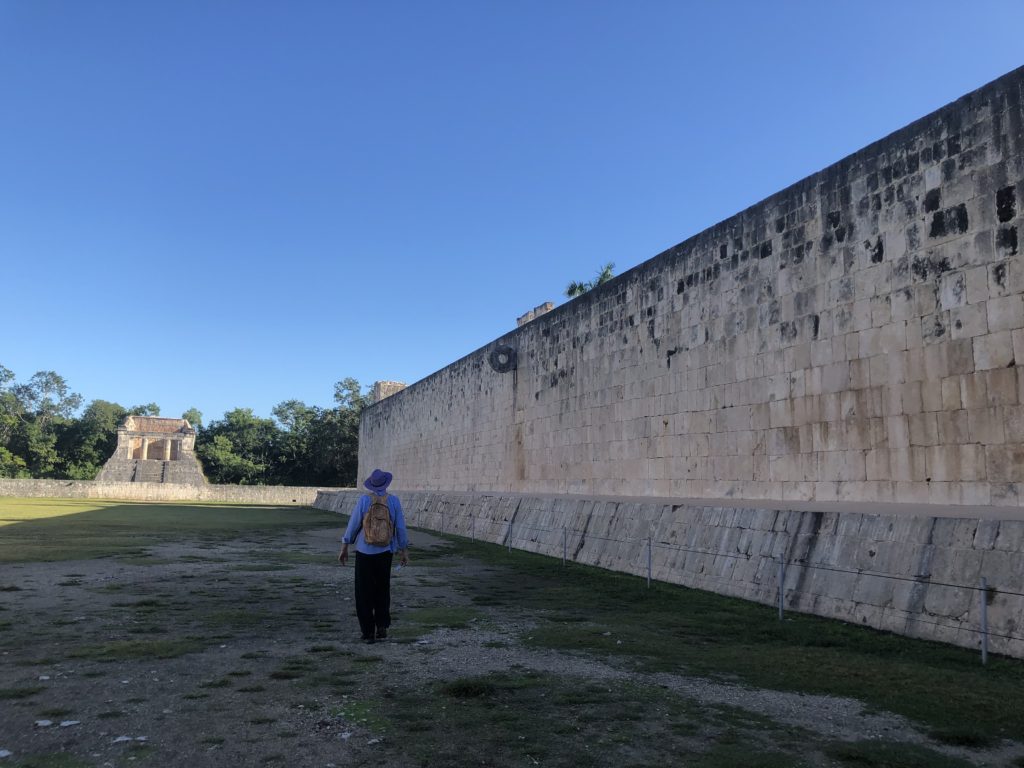
So… two competing teams with a rubber ball thrown into hoops on a rectangular court with points being tallied over a two week ballgame season. The U.S. game started 160 years ago. The Maya ball game originated more than 3,000 years ago.
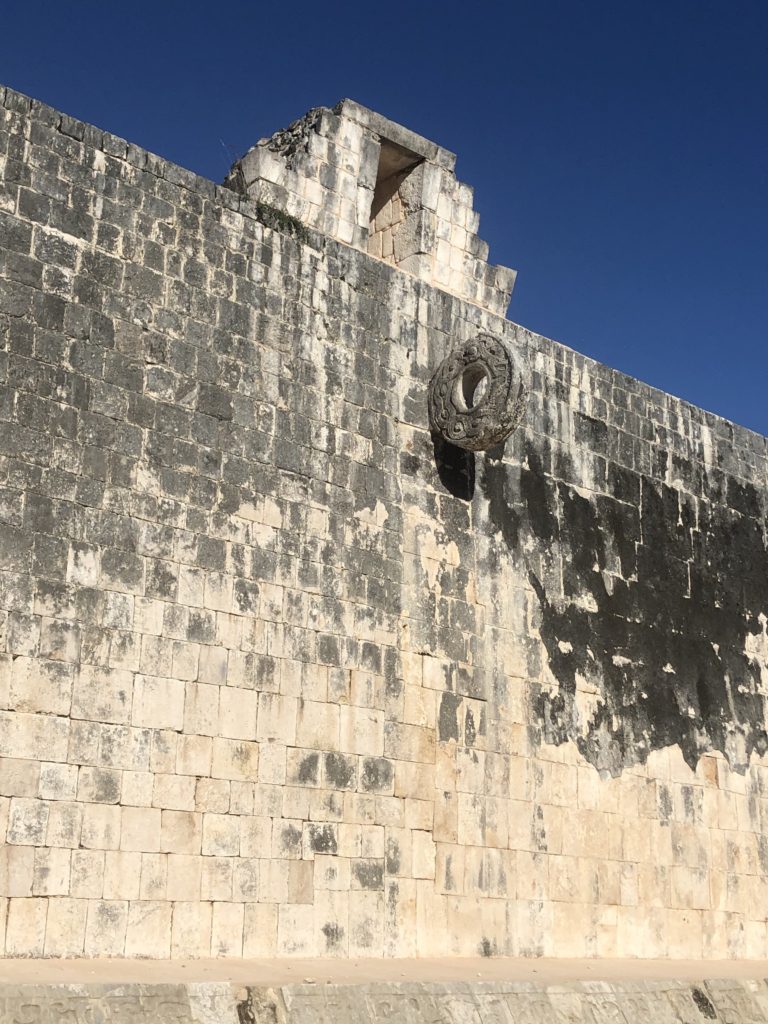
A rubber ball was always used. Its size and weight varied over the centuries. Most historians assume a weight of 3–4 kg (7–9 lb). The existence of a caoutchouc (rubber) tree was necessary to produce the ball. These trees were found in the tropical regions in the Maya territories.
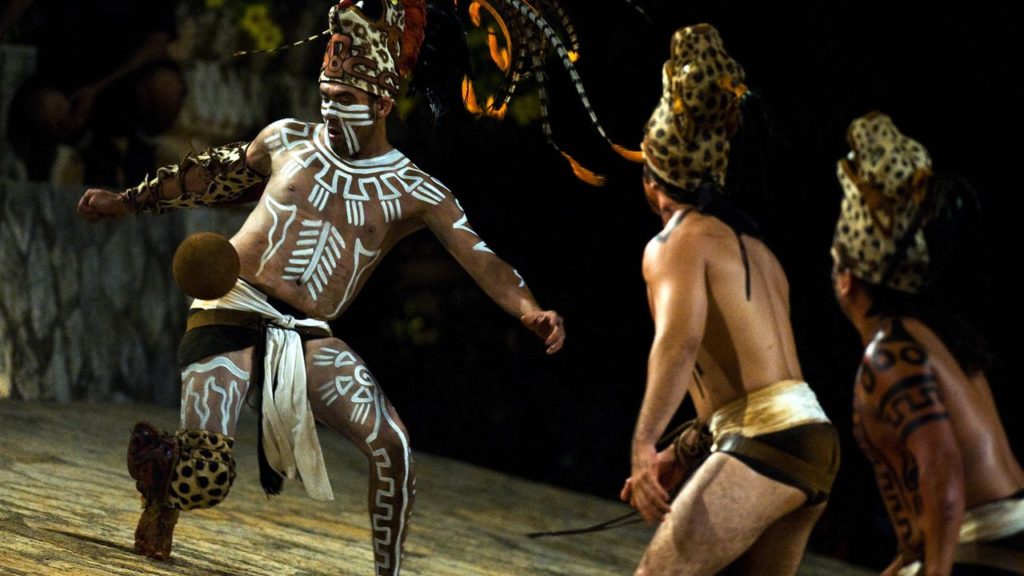
The ancient Maya City of Chichen Itza
“In the highlands of The Mexican state of Chiapas and of Guatemala alone, 300 courts have been found. Of these, 85% date back in the post-classic period, (around 1000 year BCE). High platforms on either side of the court allowed for large numbers of spectators. Arenas were decorated with portable stone court markers known as hacha, usually depicting animals or skulls. The ball court was surrounded by painted murals that depicted Mayan mythology, warriors, captives, rulers and ceremonies. “
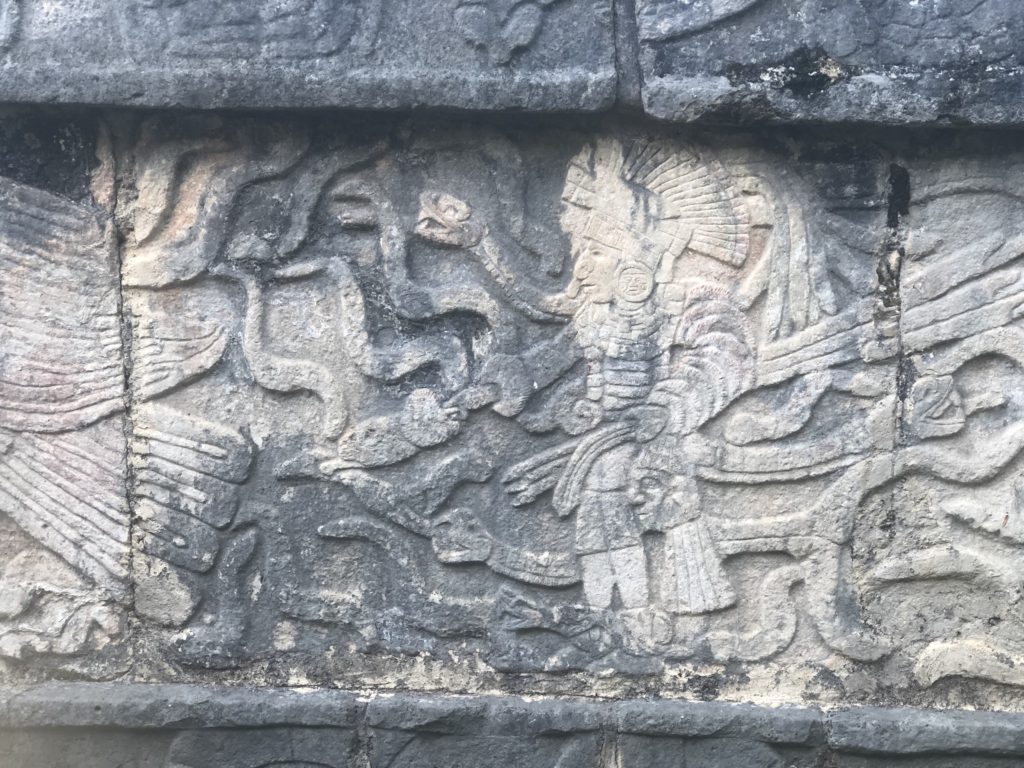
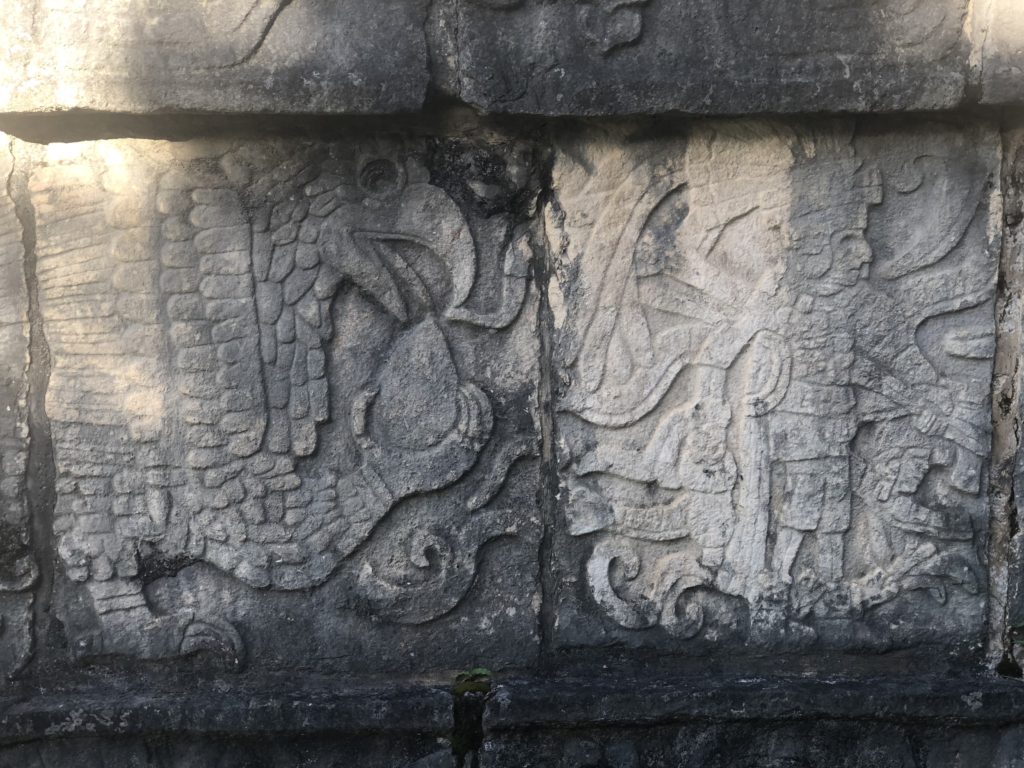
After two weeks long basketball games pitting one Mayan team of 6 prisoners against another Mayan team of 6 prisoners/players, eventually, the score card led to the human sacrifice part of the game. The stakes determinded survival. The loser team was decapitated as the ball game ended with human sacrifice. The skulls were piled on the designated skulls platform.
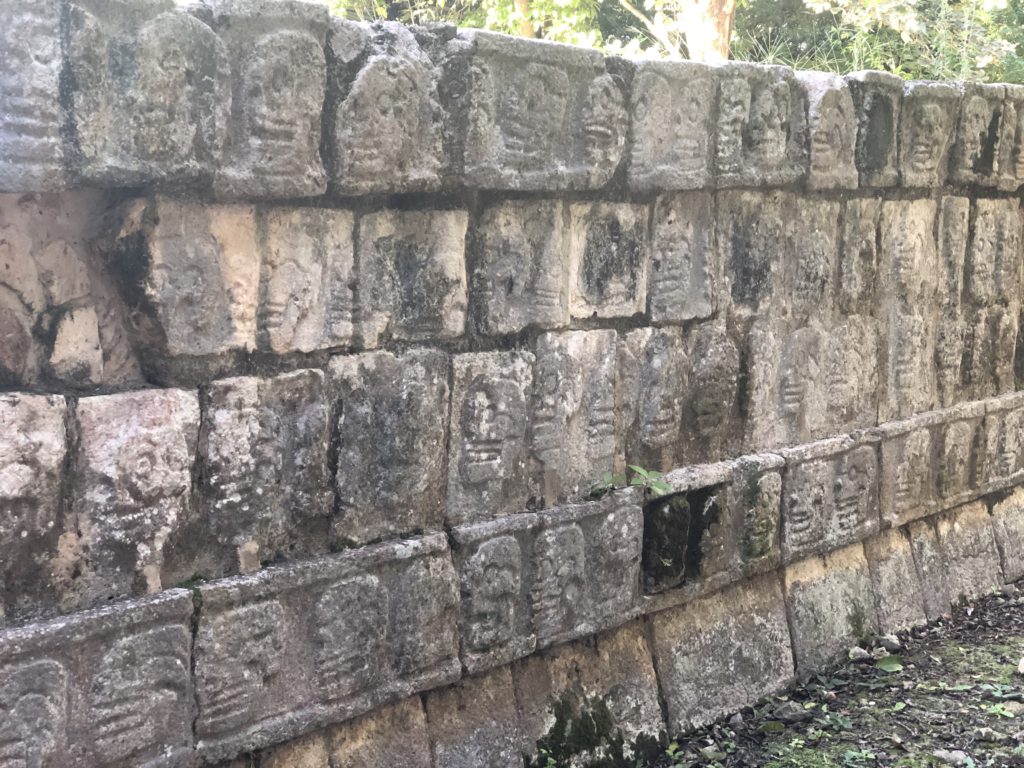
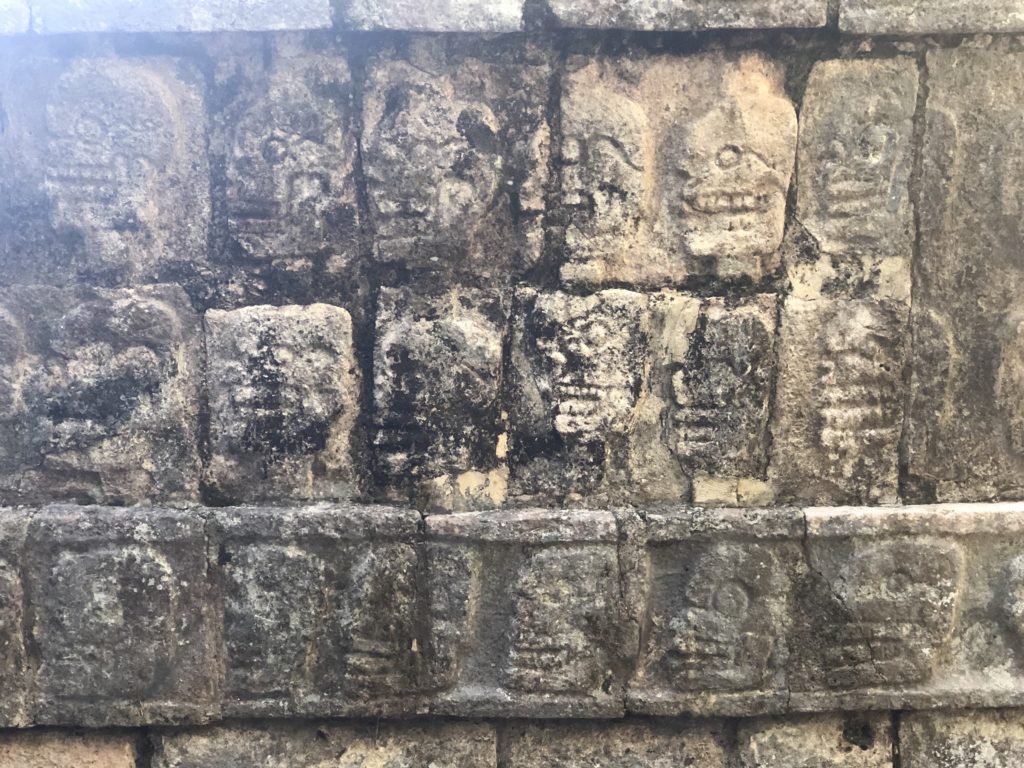
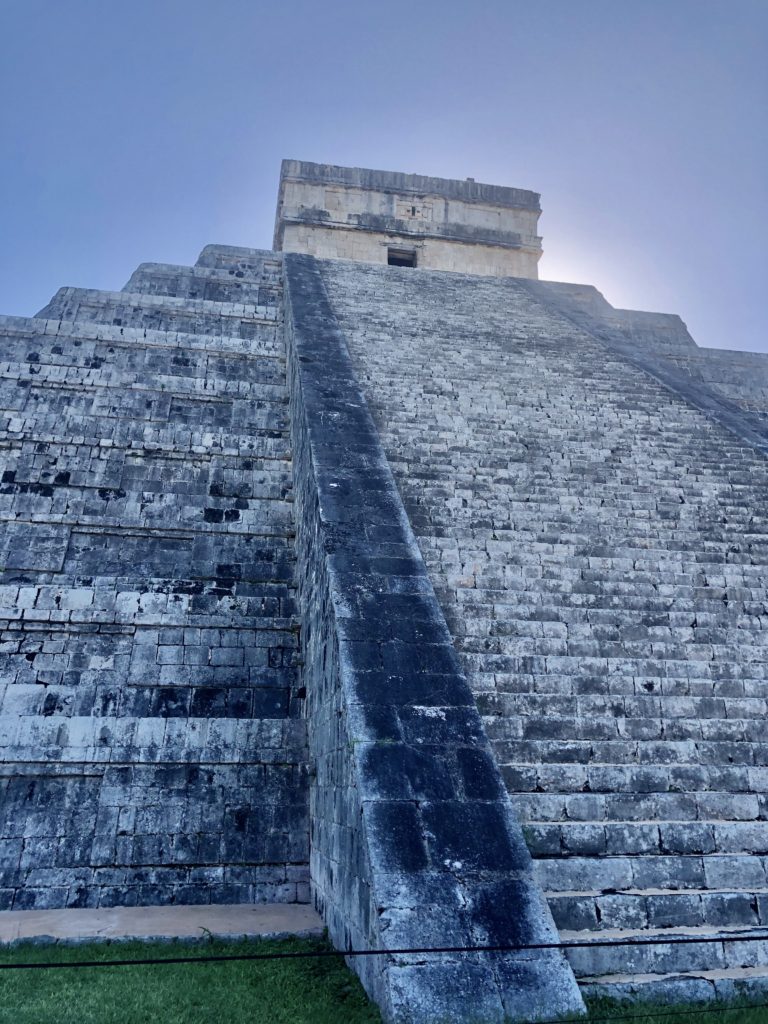
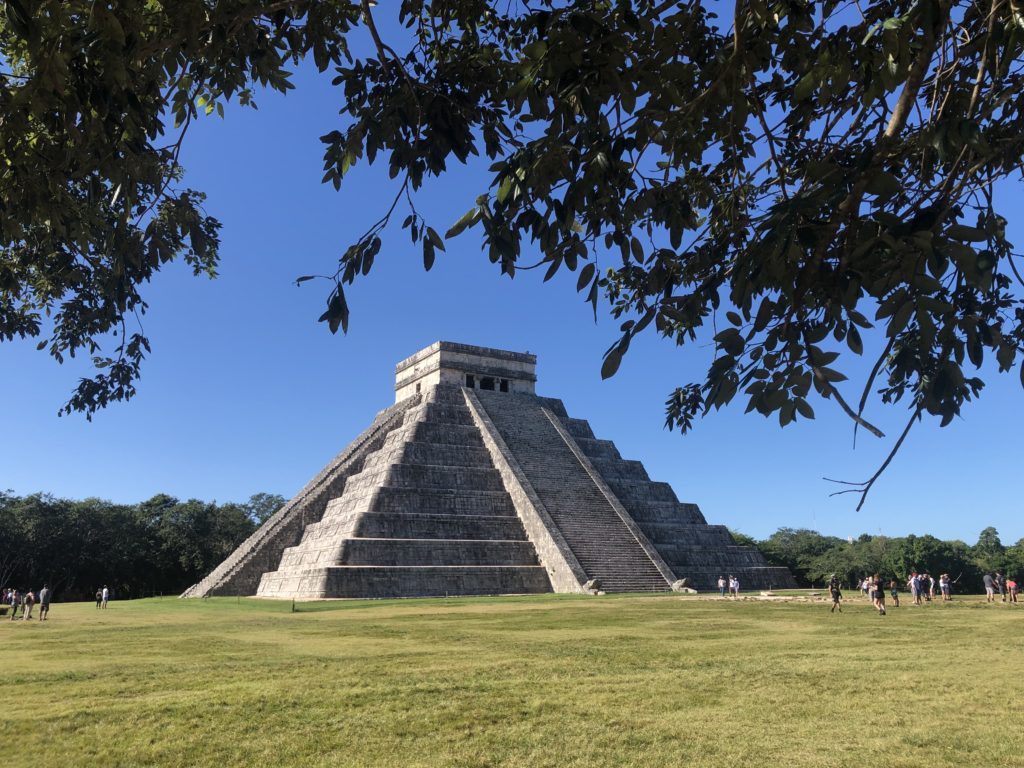
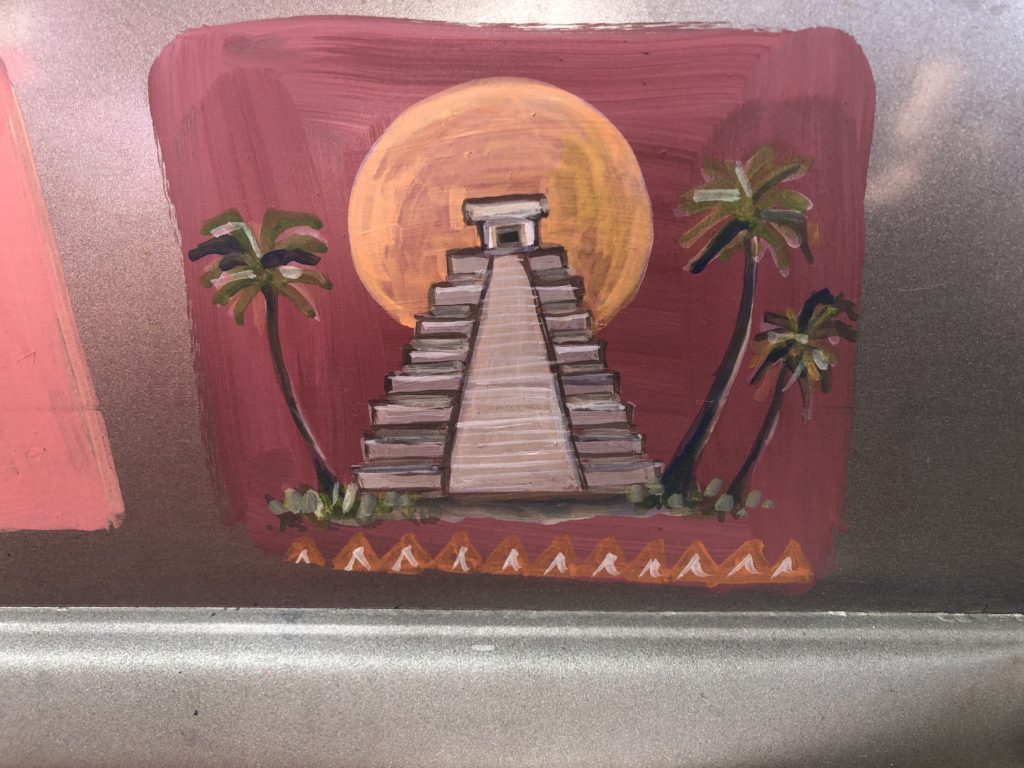
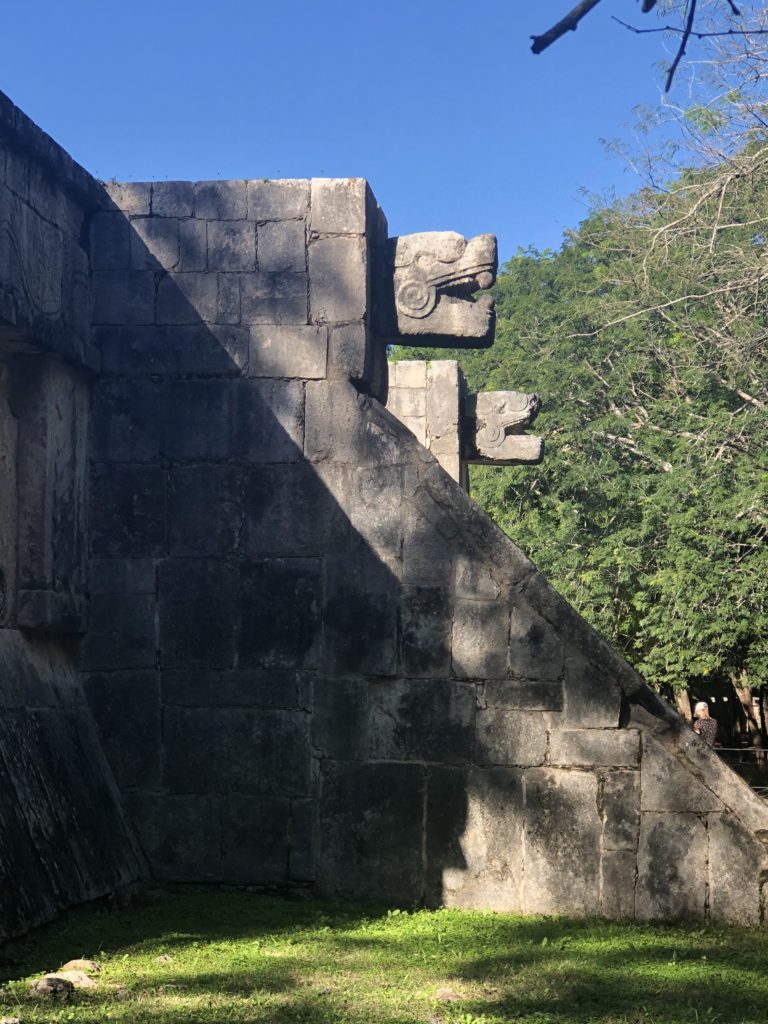
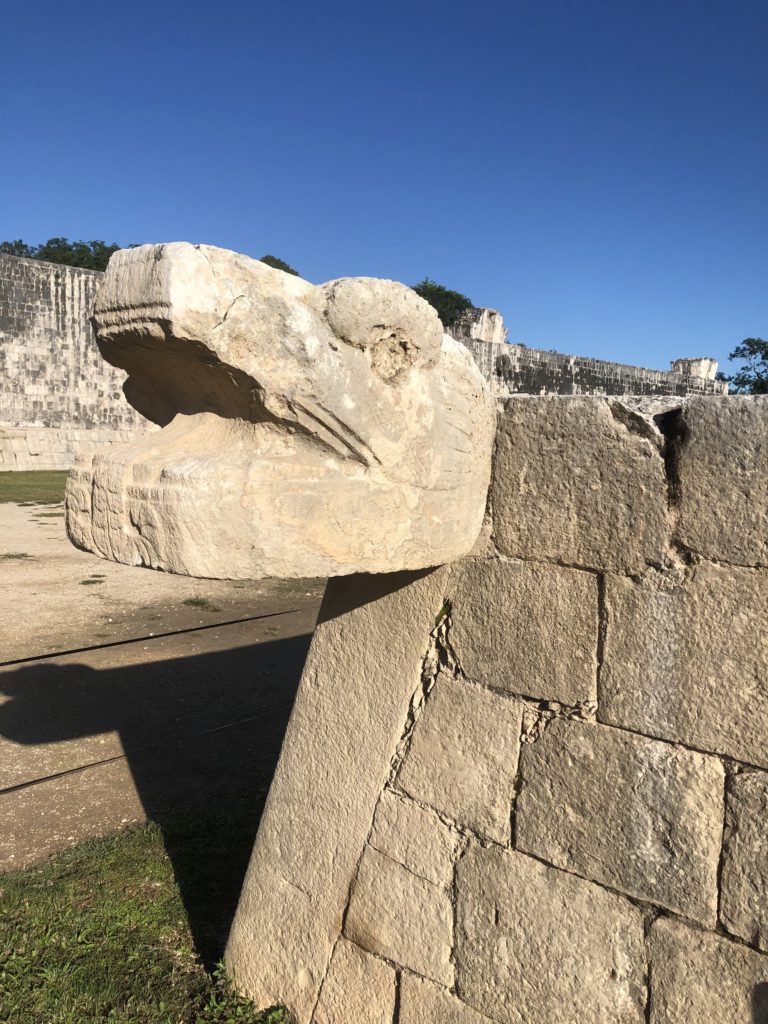
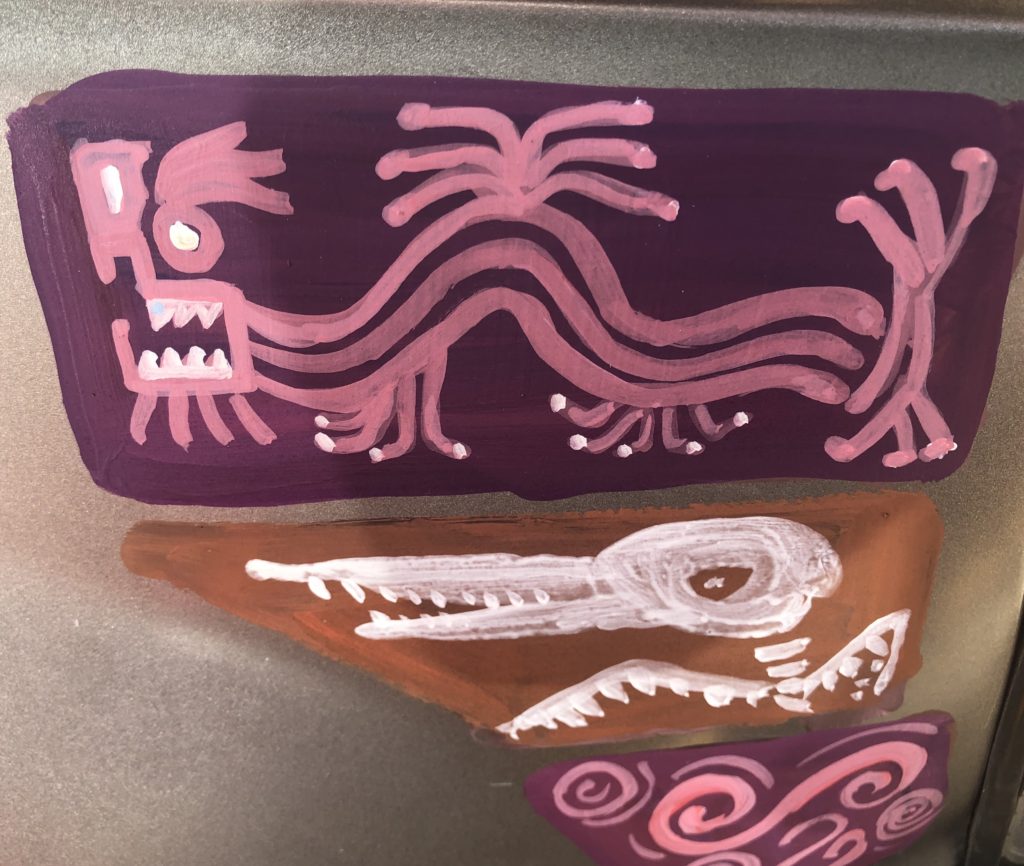
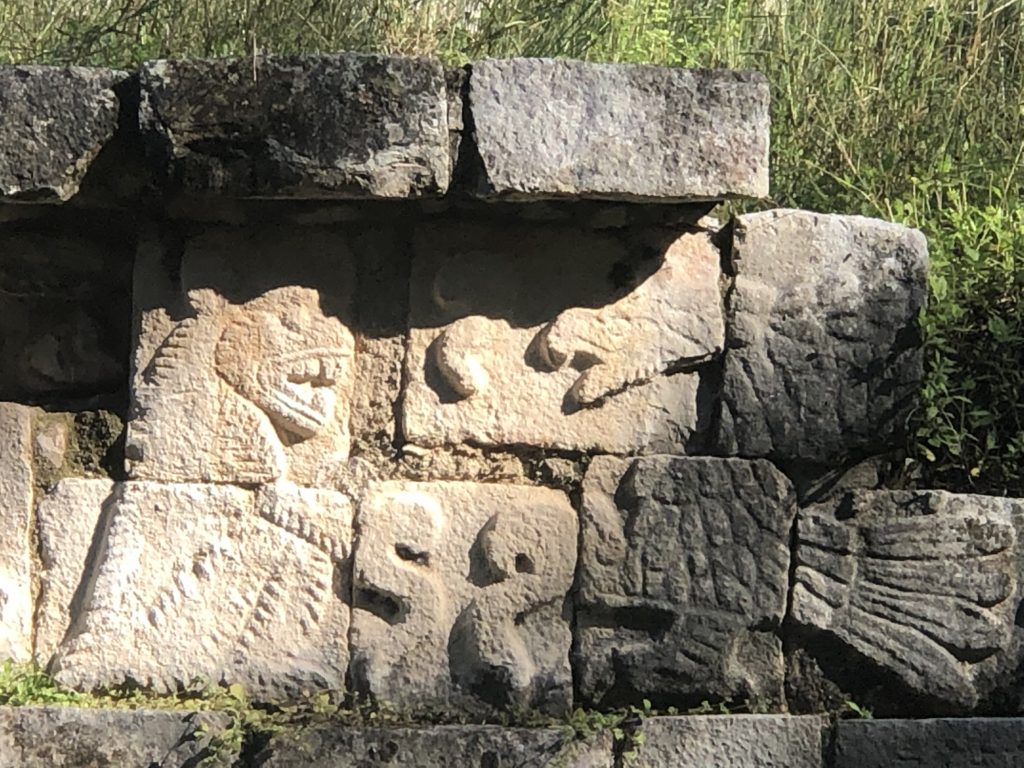
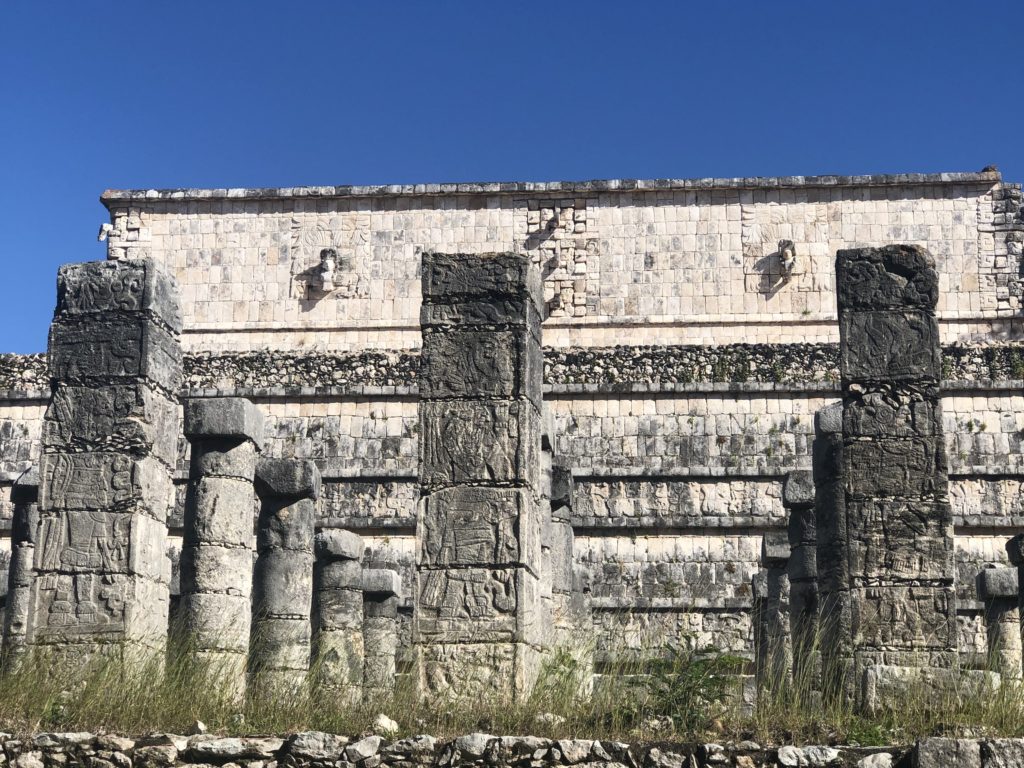
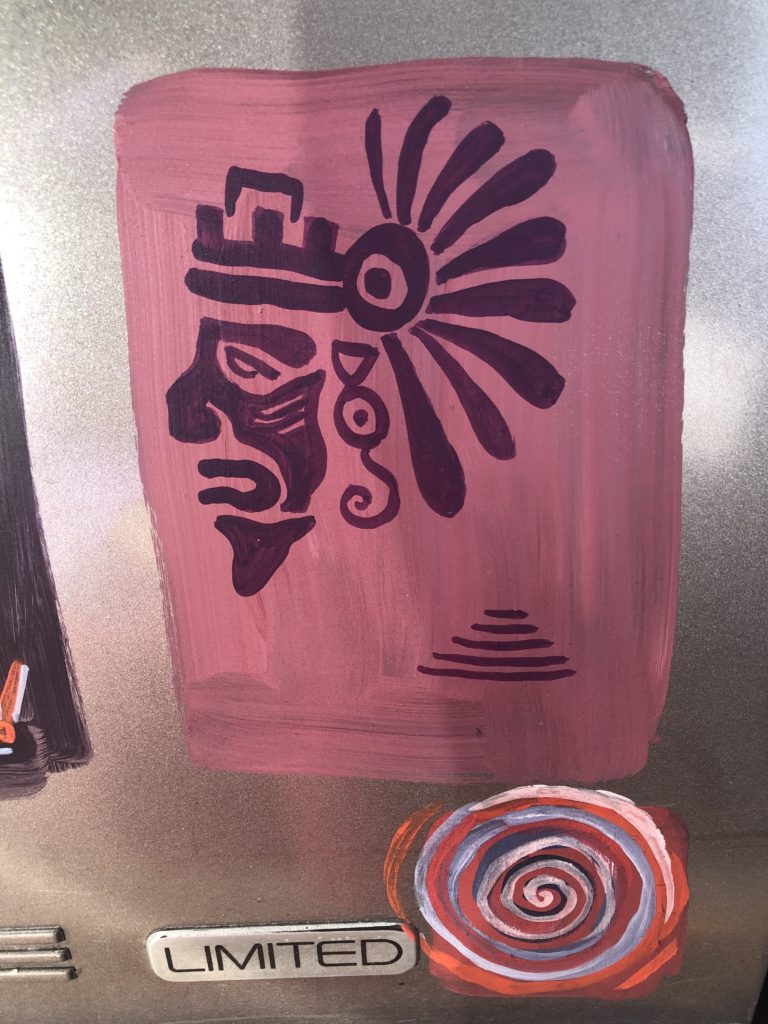
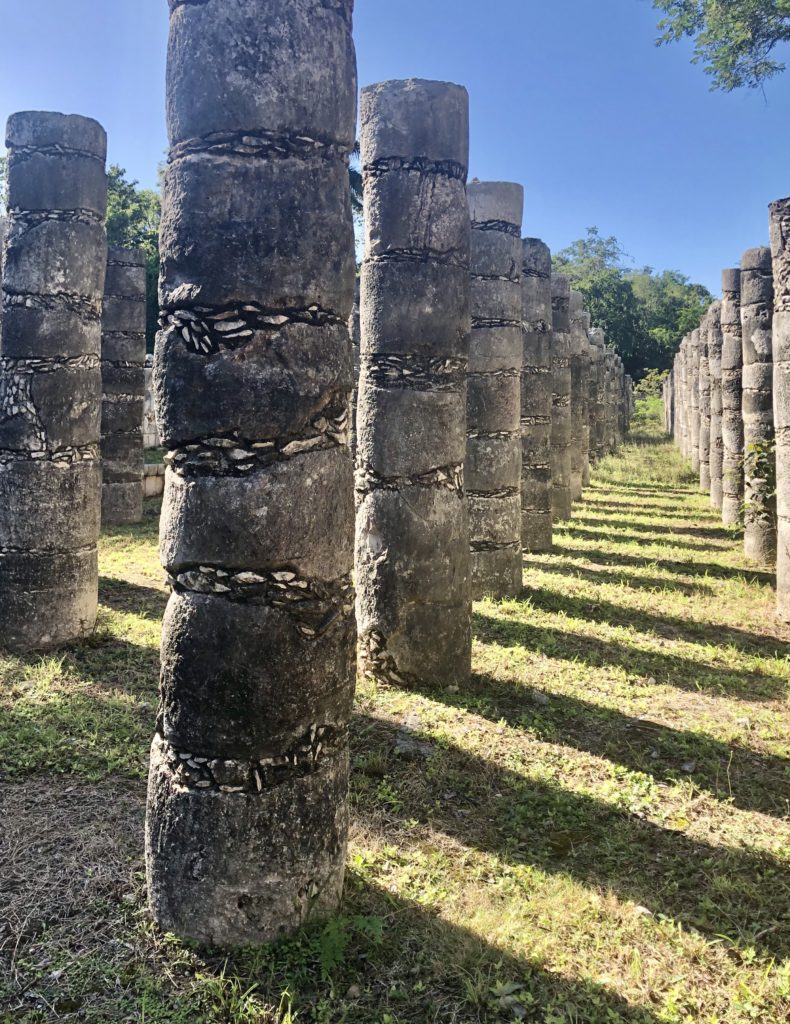
Colonial city of Valladolid
From the site of Chichen Itza we drive on to the city of Valladolid in the state of Yucatan. Another one of Mexico’s Pueblo Magico (magical towns). The city was built in 1545 on top of a Mayan town called Zaci, whose buildings were dismantled, to reuse the stones to build the Spanish Colonial town. This little city charmed us for its authenticity and everyday street scenes. It’s Spanish Colonial architecture, inspired by Moorish architecture in Spain, earned Valladolid the nickname of Sultana of the East.
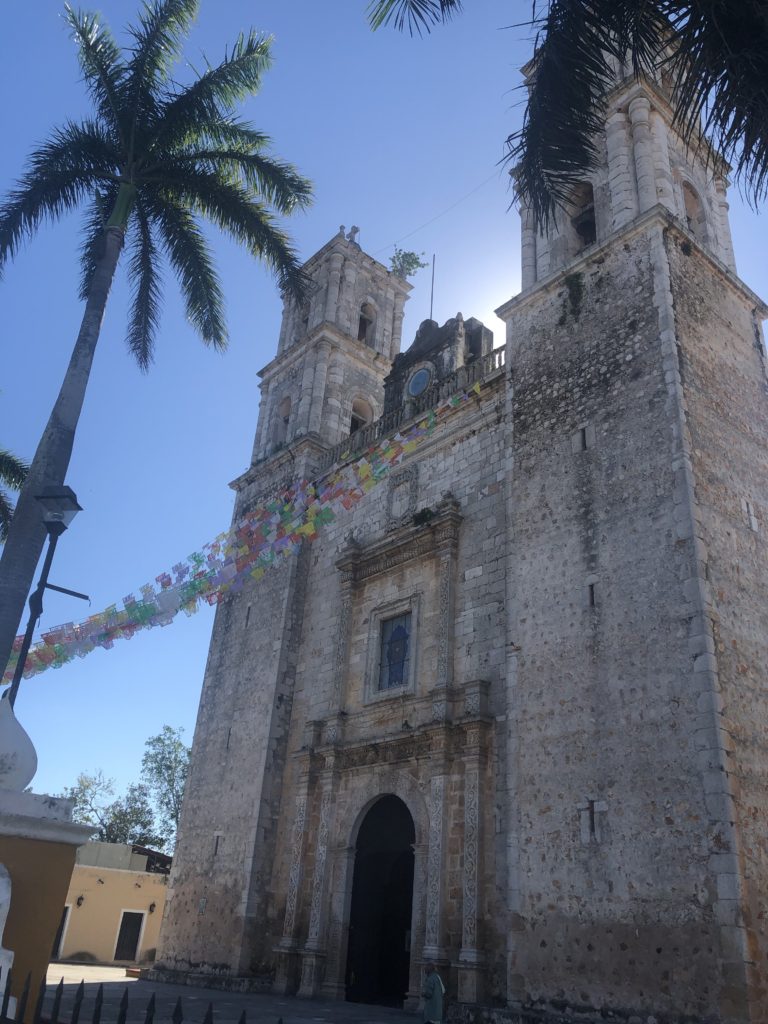
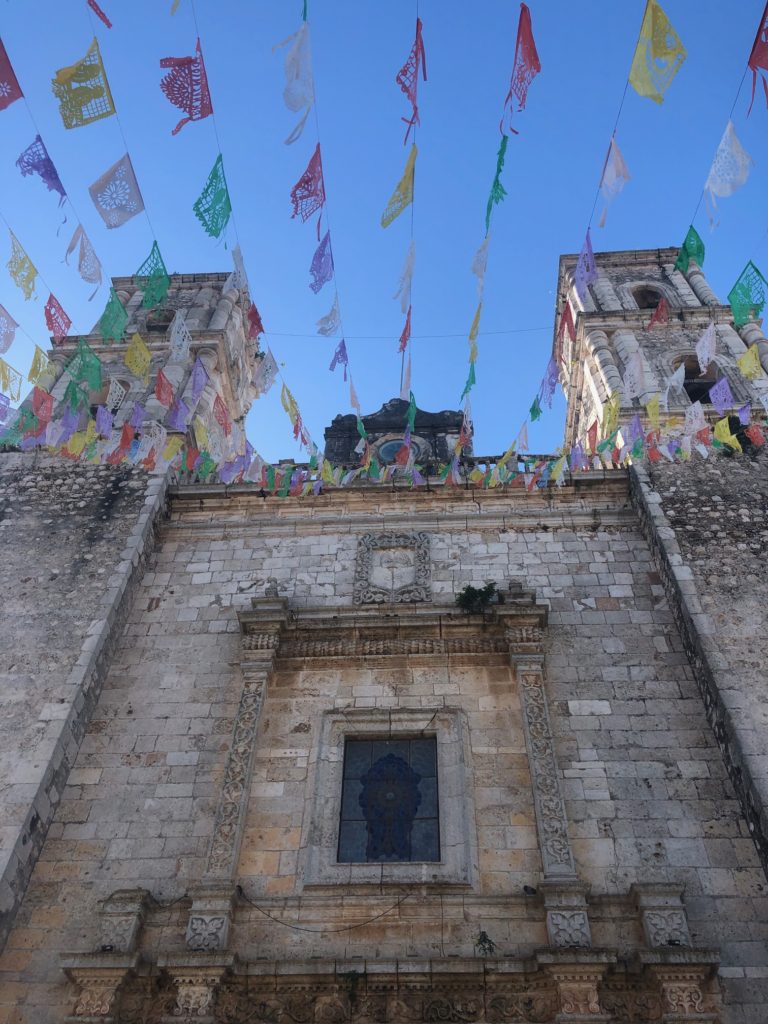
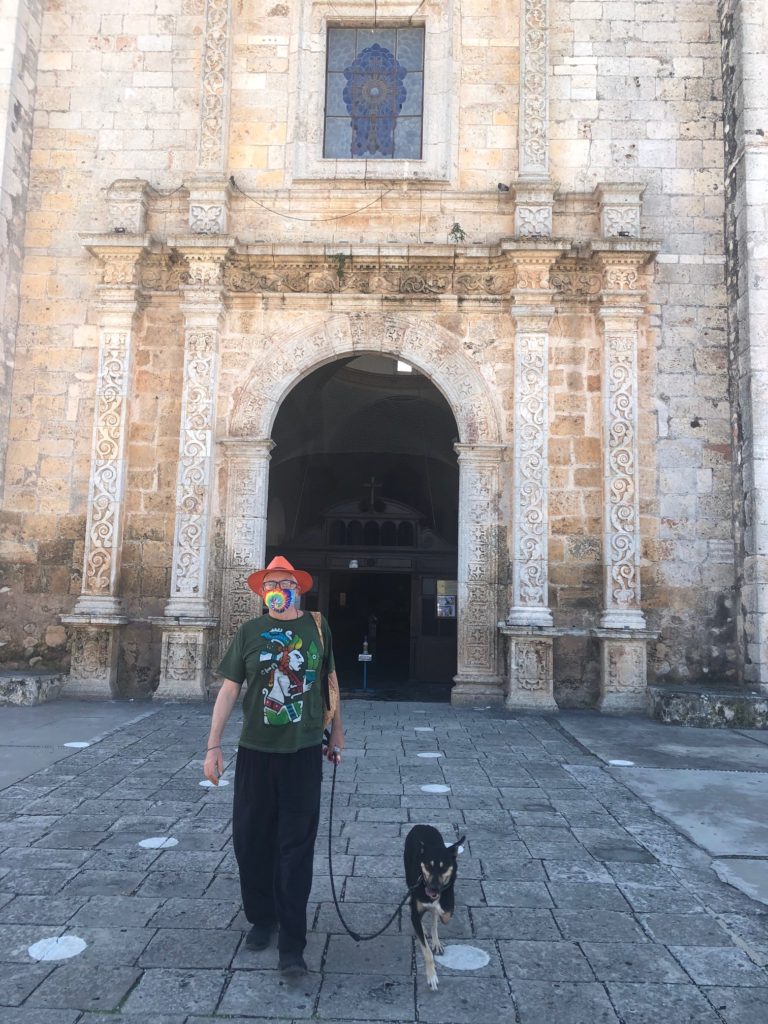
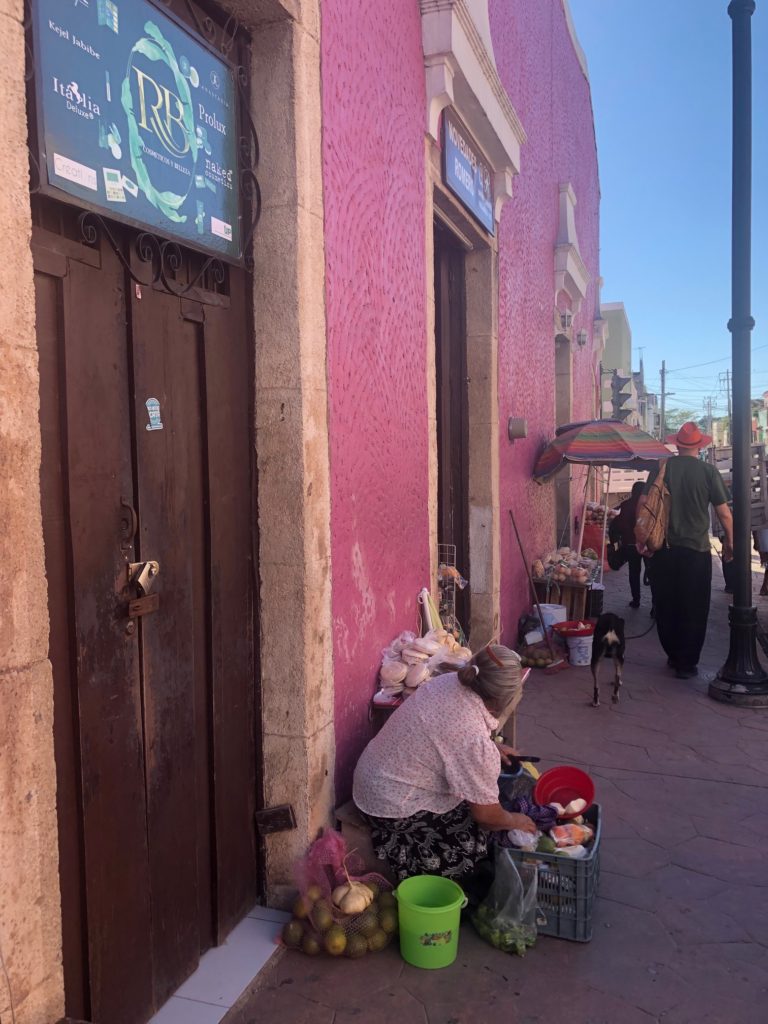
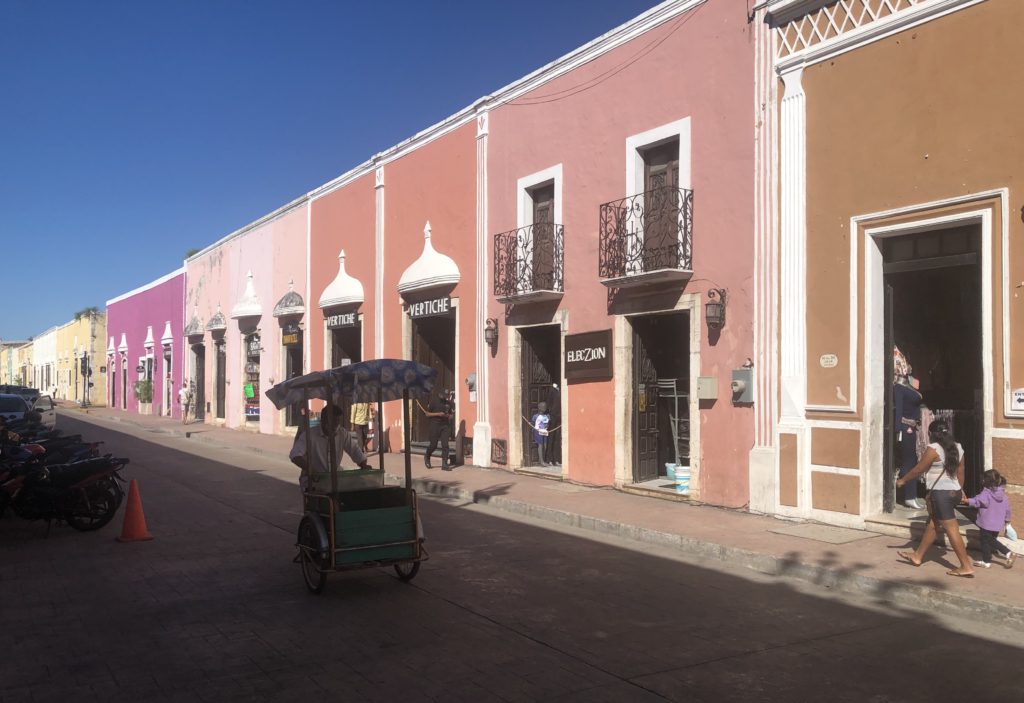
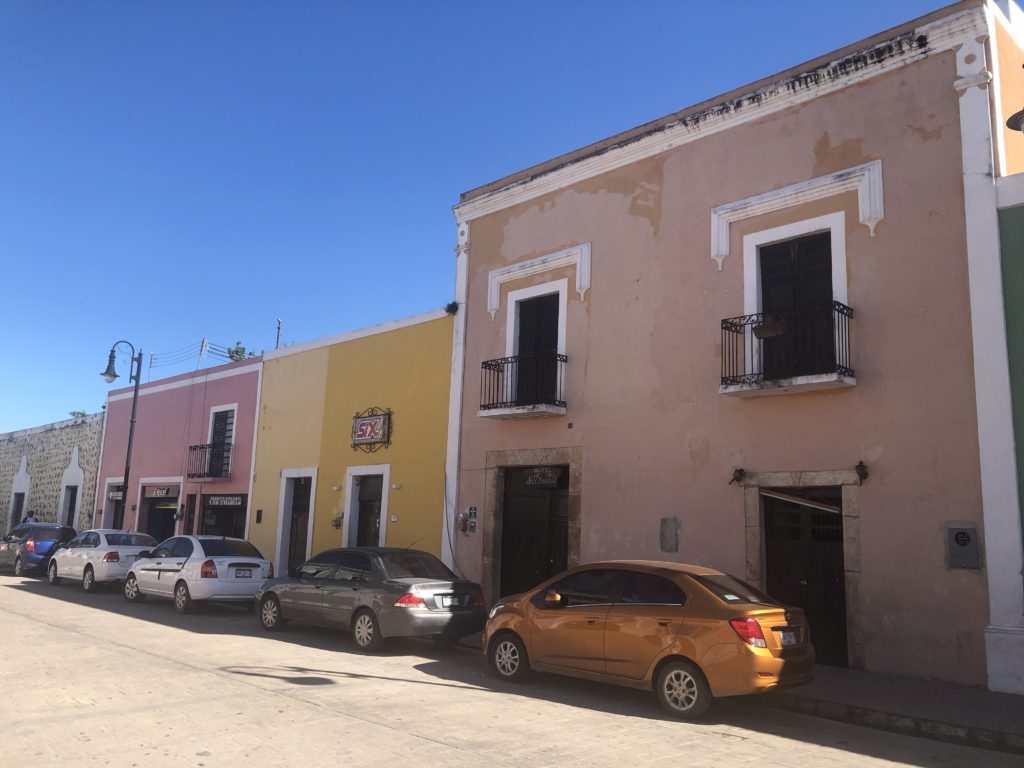

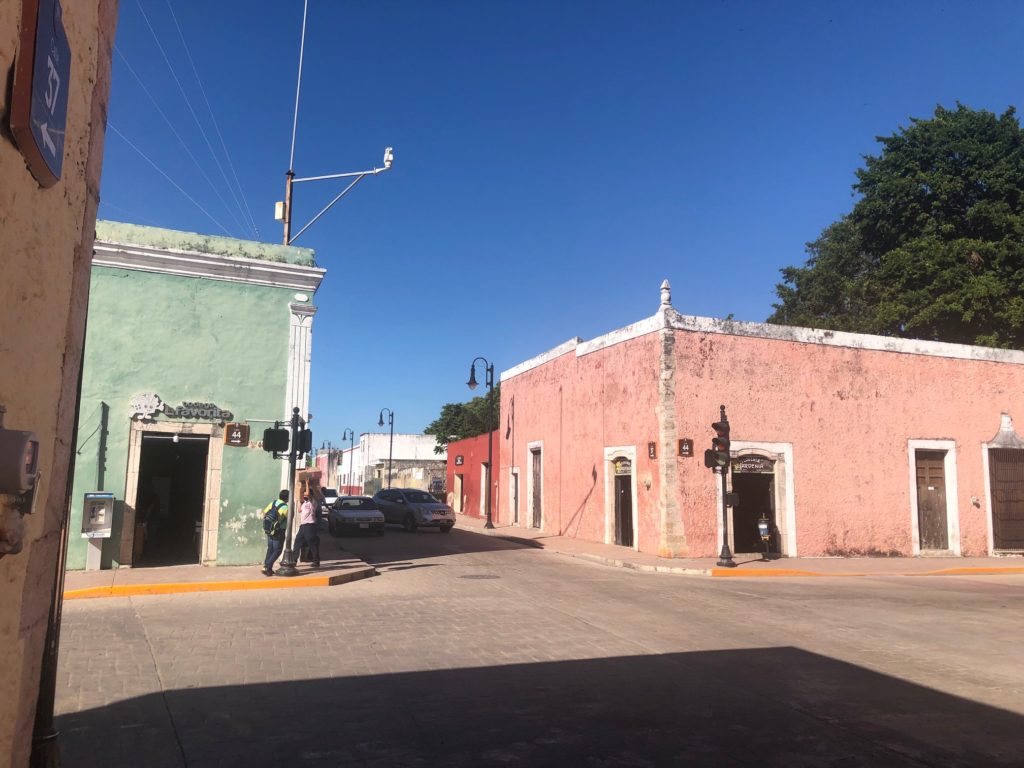
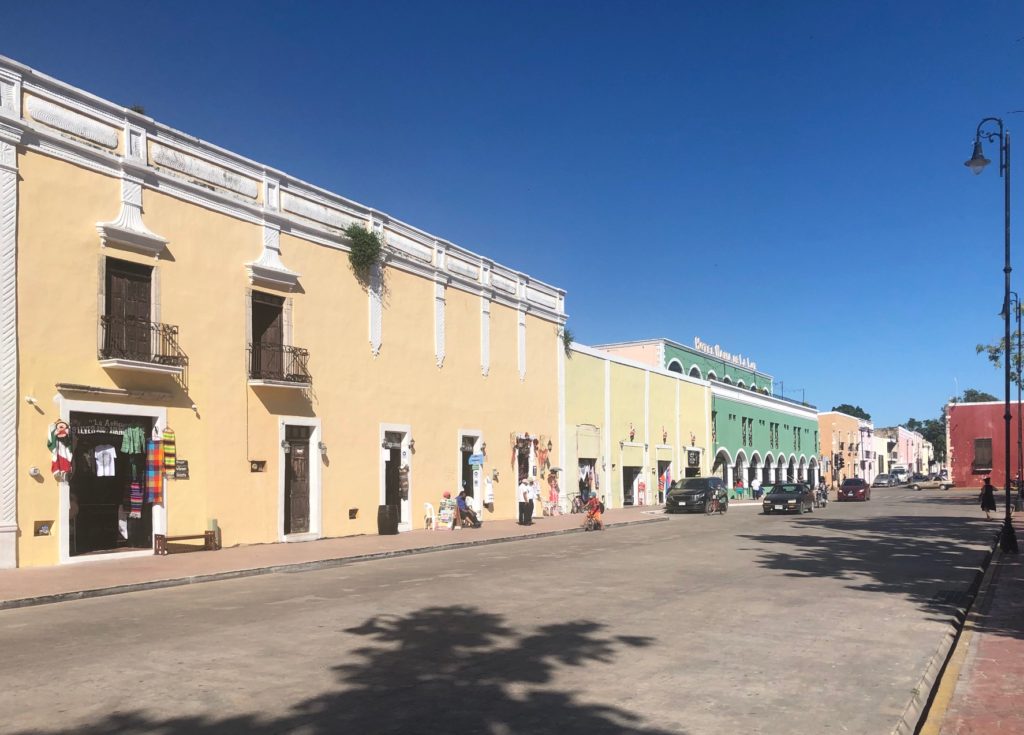
Our ten week road trip continues from Valladolid to the coast of the Yucatan peninsula.. We visited Chichen Itza and Valladolid in early December 2020.
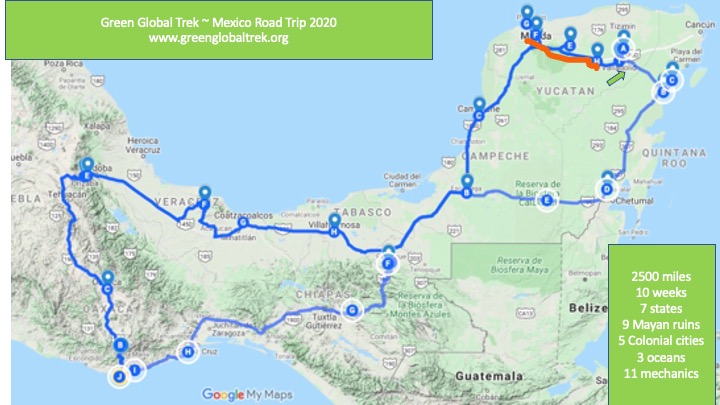
Oh, the things you two discover on your travels! I’m guessing you didn’t play a game in that ball-court, otherwise one of you would have to be decapitated. Pardon me if I decline to say which one of you would win.
Valladolid looks quite a charmer. Your photgraphs rise to the occasion, as always.
Thank you for sharing this.
BTW, I hail from Amherst, Mass where there is, to this day, an original (but non-Mayan) basketball court complete with bushel baskets.
Also by the way, Massachusetts peaches, along about August or early September, are quite sublime, as good as peaches get anywhere. As you say, who knew?
Johnny it is one of the great joys of traveling to discover new places and new interesting bits of history and information about them, for sure.
I don’t know but that hoop is pretty high and pretty small. Must have been very difficult to score points in this game ~ I don’t think either of us would be inclined to be talented at that task! Ha.
Oh how great to hear you are from the place where the bushel basket basketball gained fluency! Hope our historic revision did not offend your patriotic sense vis a vis your home town. Mmmm love good peaches. One of the great things about an American summer.
Peta & Ben
Great post. We saw the basketball court when we visited Chichen Itza a few years ago.
Peggy, were you as impressed as we were with the history of it all?
Well, there you go! There’s nothing new, just reinvented.
“Same same, but different.”
What a marvelous ‘dunk’ and discovery! I’ll have to share it with my nephews, both basketballers, who will undoubtedly find it fascinating and a cool bit of trivia to challenge and debunk what they’ve learned.
I love how you translated so much of your travels to your art gallery on wheels 😉
Amit, yes, do share. It will be interesting to see how they react to “applied history” from the Maya times. I imagine they will be relieved that the rules of the game evolved to remove the decapitation part.
Thanks re the gallery on wheels. It has become a bit of a “journal” now that we completed our road trip to the Yucatan and a reminder of so much imagery that became a visual portfolio for this trip.
Ben
A great bit of history here. Your road trip in your art gallery on wheels turned out well. You saw so much! And had most places to yourselves. Hope you and Enzo are doing well these days. xo
Darlene the road trip in the art gallery was amazing, our art gallery on wheels was attractive but definitely gave us a run for the money! Many trips to many different mechanics along the way. Still we use the car today, mostly for small jaunts here and there and it continues to attract attention.
We did have places to ourselves… which was quite the treat. Not a fan of crowds. Esco is doing very well, actually we have been in the U.S. for five weeks but heading back to him and our home on the coast in a couple of days.
Peta
Enzo will be very happy to see you again! I’m sure it was wonderful to see family and friends after all this time.
I love discovering and learning ‘new’ histories that challenge what we previously believed.
Thank you for continuing to take us along on your travels – I always enjoy every single moment and every single photo.
Those are hardcore win-lose stakes!
Donna we enjoy that aspect of travel, very much. For me, I never learnt much history in school anyway, (being a bad student and all that) so much of what I learn during our travels is a first for me in many instances, especially when it comes to history and ancient civilizations and their respective contribution to global history.
Thank you for such a lovely comment. Thank you for traveling along with us.
Those ARE hard core win lose stakes, yes!
Peta
What fascinating history – in fact, one of the reasons I so love your blog is I always find out things I didn’t know. And your great photos, of course. Our local Bowers Museum has ( or had) an exhibit of Mayan rubber ball playing but I couldn’t tell the enormous size of the court. This sport rivals ancient Rome’s gladiator competitions. I like your roving art gallery. Please let me know when it will be in Orange County.
Sharon how interesting that your local museum had an exhibit of Mayan rubber ball playing. We were at several other archeological sites during our Yucatan road trip, that had ball courts as well. The hoop is vertical and rather small, so the players must have needed a tremendous amount of skill. Yes, the court size in this instance was very large, others were smaller.
Quite right about the gladiator comparison. Didn’t even think of that…. The Mayan games would have been roughly a 1,000 years before that!
Haha I am quite sure our roving art gallery would not make it that far!
Peta
Another beautiful, informative post! Thank you Peta and Ben!
Deb
Thanks Deb. Most welcome. Glad you enjoyed it.
You learn so many interesting things when you travel! And thanks for sharing your journeys with the rest of us, too.
Ann, one of the best parts of travel is the real time learning that occurs, at least for me anyway. Much easier to relate when I can see something, be it politics or history or geography.. Being there in person piques my interest in a way that reading or learning in school, never has.
Glad you are enjoying our journeys…
Peta
The map is always very helpful, Peta and Ben. It gives me a frame of reference where you are visiting. Very interesting about “legend” and “historical fact.” Also interesting about a ball court symbolizing a city’s wealth and power. I appreciate seeing the stone hoop up close, since it is difficult to imagine. Good grief about the fate of the losing team.
I recall how I was and am in awe of your art gallery on wheels. The photos are always fascinating. I can (almost) feel the languid and chill. Thank you for sharing a wonderful, entertaining and informative post, as always.
Erica, maps are very much part of the journey and the learning process. It’s also so much fun in retrospect, to see the directions we went in. There are always choices to be made about which direction to choose and in the end, there are no doubt pros and cons with any choice that presents itself. So the map is a good summary of that perpetual decision making process.
Thank you for the kind words. It’s nice to know that our posts are not only informative but entertaining as well…. 🙂
The art gallery on wheels lives on, the car has not died yet, and we still use it for short jaunts around town or to a close by beach and for that purpose it actually is a great car. But long distance, I don’t think the art gallery will get that opportunity again! My nerves couldn’t stand it….
Peta
Sorry we missed this part of the trip. It’s weird to hold the awesome beauty against the violence, impossible to understand the mindset. Humans are so strange. Excellent post.
Sharon, as you know, we thought so much of you and how much you would have appreciated the visuals of Chichen Itza. Well, there is always next time! But seeing those rows and rows of skulls, we did feel you were part of this particular trip as you had chanelled Chichen Itza.
Each age in history has it’s own folly… of which, there is no shortage.
Peta
Every day is a school day!! Travelling really does broaden the mind and there is nothing like learning the actual history behind the legend. I would love to visit Mexico again and to explore further, your blog posts are a great inspiration for a Mexican road trip. Your “art gallery on wheels” was such a genius idea, I absolutely loved it and so very Peta.
Thank you for providing the map of your road trip, it is very helpful.
Gilda, nice to read you! Very true that history comes to life when we travel. I do hope you both get a chance to visit Mexico again and explore other destinations and hopefully we you do come we can meet again and do another food hopping round! We are in Mexico City right now for a few days and it is remindful of parts of Asia, for its rich culinary scene.
Ben gets full credit for the art gallery on wheels idea as a concept. Then Sharon and I were the laborers ahaha.
Peta
We have been to one of these ancient stadiums when our children were younger. I can’t recall whether I had forgotten about the human sacrifice of the losers or whether the guide chose not to share that.
As Gilda shared I too very much like the inclusion of the map in this post and others. It’s one thing to tell readers of travels but to provide tools on how they might experience it is a great help.
Sue part of the reason we created that map was as a diary and reference point for ourselves for future use and as a reminder of where we went. Because we well know that in a few years, the details start to blur…
Good call perhaps by the guide to not give you that piece of history with your kids present. In fact, they also used to throw people into the nearby cenote (water hole) if they had done something which they deemed deserving of punishment. The cenote had a creepy energy once we knew the history behind it.
Peta
This sure brought back some good memories. We were charmed by Valladolid. And loved Chichenitza – what a remarkable place. The whole Mayan civilization was pretty extraordinary, and brutal by all accounts.
When we were in Valladolid it was very busy so maybe some of the quietness is because of the pandemic – no tourists.
Valladolid was the one place we really wished we had spent more time as it was so authentic and yes, very charming. We had a home exchange waiting for us on the coast so that provided the pacing… We saw no other foreigners while we were there and it was definitely on the quiet side.
Peta
Not that I am a particular fan of basketball or have any stake in its history, but I have always thought of the Mayan court ballgame as a very different sport! Of course, there were the stakes, but other than a ball and a small place to throw it through, my impression was that the games were quite different in their play, at least from what I gathered at my own visit to Chichen-Itza. Either way, I’m glad the grisly ending of the Mayan game was never imported into any other country’s sports! (P.S. the use of cenotes as spots of human punishment or sacrifice is one of the reasons I have never been able to enjoy swimming in them!)
Lex, you are right, but I guess it’s all a matter of where you draw the line of what is significantly different or not. For instance, the Mayan game requires the players to use their elbows and knees to move the ball, not their hands and basketball is the converse. So at that level, yes it is different. But compared to other sports of that era (Roman horse carriage races or disc throwing), two teams competing to throw a ball in a hoop is a fundamental as I see it.
The cenote at Chichin Izza was particularly creepy .. not sure if it was the history or just the fact that physically some of them are a bit scary looking. And then others, are shallow and have a different energy, more of that on the next post upcoming.
Ben
I have heard of the ball courts in ancient Mayan culture but never equated it to modern day basketball. Now that you show me those stone hoops it makes sense. Guess there wasn’t a lot of give on a slam dunk 😉. Those stakes were high; what a gruesome end for the losers. Thanks for the fascinating history lesson. I have some big basketball fans in my extended family and look forward to sharing this.
Your paintings of the Mayan symbols are awesome. You have such talent.
Valladolid looks charming. Those coloured houses make me smile.
All the best to you and Ben!
Caroline
Ahh Caroline, the equation is Ben’s take on Mayan sports and I suppose that basketball aficionados might consider that a game where one uses ones hands versus ones arms and knees is fundamentally different but to him sure seems that the 3,000 year prior history of ball in hoop is fundamentally the same. We will be interested to hear what THEIR take is…
It was interesting to research the Mayan symbols, paint them and then later see them for ourselves in person. And that kept happening and made those symbols all the more meaningful.
The colored houses apparently have a requirement that they need to be a different color to their neighbor and other than that they have free rein. Different to the town that required all of them to be yellow ochre!
All the best to you two as well. Hope you are doing well.
Peta
I visited Chicen Itza many, many years ago so it was great to see that beautiful area again. Someone may have already asked this, but are you still able to climb to the top? (It looked like there may have been a rope around the base.) I love that your art gallery on wheels is an ongoing project as you are finding inspiration wherever you go.
When we were there, one could NOT climb to the top, due to the pandemic. Not sure why climbing up as opposed to gathering at the bottom makes a difference, but perhaps it discouraged some from visiting.
The art gallery on wheels was painted weeks before we visited Chichin Itza. We had done research on the images and their meanings and used them, and then they came to life and had so much more meaning once we saw them for ourselves at the sites.
Peta
I love this post! You know how much I adore ancient buildings, especially those adorned with intricate details carved on stones. Mexico remains on top of my wishlist, although this pandemic makes that dream of visiting those Mayan ruins seem rather remote. What amazes me is the fact that us, humans, despite geographical isolation managed to develop similar forms of art that we incorporated in the sacred edifices we built. How lovely it must have felt visiting Chichen Itza when the usual crowd was largely absent.
Thank you Bama for your comments.
Yes, there is definite convergence of imagery amongst ancient civilizations. None perhaps as striking as those images that convey the concept of extra terrestrial entities visiting humans from the sky on their floating vehicles! I imagine we have seen the same beautiful wall murals in Phnom Penh in Cambodia on the royal murals, which depict humanoid creatures descending on beautiful chariots in and amongst Cambodian society. Similarly Mayan temples are replete with carvings of humanoids that have helmet like apparatus.
Wonderful to be at such a popular site with just a handful of other people. We felt very fortunate to be able to view it like this.
Ben
Potato, Potahtoe… soccer, or as the rest of the world calls it football, is another example of American etho-centrisim. Using one’s hands -vs- ones knees and elbows, who knows? Fun story though! Fascinating to think of sporting events 3,000 years ago!
Love all of the pictures, it’s another country we’ve yet to explore so it’s fun seeing/reading it through your eyes/words.
By the way… did you make it to Yosemite on your California road trip? I remember you were thinking about it but I don’t recall seeing any posts, although I may have missed them as we were on the road for a month.
Patti one of the interesting aspects of visiting archaeological sites is that we get to do a form of time travel. It is not just the sports.. for example, in one of the sites we went to there was a whole market street where one could easily visualize Mayan vendors with their ware.
Hope you do get to explore Mexico, we are enjoying the process of a slow discovery. There is so much to see and so much to learn about and experience.
We decided against Yosemite because of reports of high volume traffic, trouble finding reasonably priced accomodation in that area and we chose Mt Shasta instead. Our road trip was primarily about seeing family so we just had a few days to ourselves for further exploration.
Hope you had a good road trip too. Thanks for stopping by to read us and leave your comments.
Peta & Ben
What a fascinating post. Well, except for the beheading business. That was fascinating, too, but in a somewhat different way. I suspect no one was eager to be on those teams, but I also suspect the players worked hard in practice. Losing meant a bit more than getting criticized on social media!
What surprised me most was the rubber ball. I wouldn’t have assumed they had the technology to produce such, but a lot of my assumptions about the Mayan culture have gone by the wayside!
Good to know that this post caught and held your interest. We were fascinated by the story behind the ball court we stood on and also really enjoyed thinking about all of it while we were there… bringing history to life, in a sense.
One of the most interesting aspects of Mayan life was their mastery of astronomy which far surpasses ours today, but that is a whole other post in and of itself. Suffice to say that the notion that we get smarter over time is very much challenged if one recognizes the Maya’s ability to interpret the sky and apply the knowledge to daily life.
The balls were made from the sap of the rubber tree. The Aztec, Olmec and Maya of Meso- America are known to have made rubber using natural latex. As reported in National Geographic “ancient civilizations in much of Mexico and Central America where making different grades of rubber three thousand years before Charles Goodyear “stabilized” the material in the mid nineteenth century. In fact they didn’t just use rubber for sports, by mixing up rubber using different proportions of latex ingredients they developed multiple products, for instance, rubber sandals which were described by Spanish conquerers but archaeologists never found evidence.
Peta & Ben
Ah…Chichen Itzá…I’ve always wanted to see it and never been able to as of yet. How thrilling to pore over your lovely photographs of the place as I imagine myself there studying the carvings, the ball hoop, and taking in the whispers of history.
I do hope you get to see it one day, or if not that site specifically then one of the many others. Little did we know at the time of seeing Chichen Itza of the delights that would unfold at other smaller sites along the way (for future posts, we are way behind on our posts of this road trip).
Thank you for stopping by to read us and to comment on our blog. Travel posts are so useful for stimulating our imaginations of places yet to be visited.
Peta
I always love learning new things from you two, and this post is no exception. Not being a huge basketball fan, I didn’t know that it had been considered an American original sport. Good thing, since turns out that concept is false. But oh, I’m so glad the stakes aren’t so high now. Reminds me of the gladiators, where the losers lost their life. Fabulous photos. Hope you’re back home now after a wonderful visit with family.
Yes, we are back home in Zipolite after a wonderful road trip and visit with all the family in various parts of the country. We also stopped in Mexico City on our way back and enjoyed five days there getting to know it a bit better. Wonderful city.
True, very remindful of the gladiators. Sports then were a matter of life and death. Even though things have improved today, we still have soccer players in Europe and other places that consider committing suicide when they let in a goal or miss a penalty shot. So it seems that sports still have tremendous stakes and reflect the pressure that athletes are put under still today.
Peta